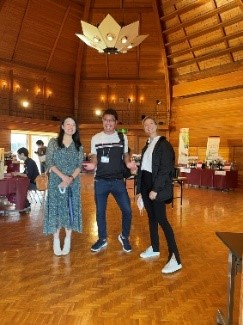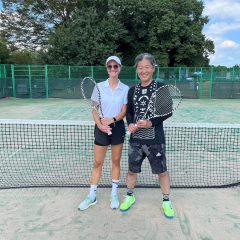☆☆☆ Fourth report from Christina Neumayer, twentieth scholar of the Grünwald foundation ☆☆☆

The first two months of my stay are over, and I already know that I will miss the country and the culture, especially the calmness and serenity that is revealed in so many aspects.
Especially in the last few days, I had some more cultural, unique, very stimulating and memorable experiences. For example, I got to know the beauty of Japanese cuisine at a bento cooking class in Kyoto. We prepared many, small specialities, which were then served together in a bento box. The term bento means “food to go”. Bento boxes were invented a long time ago in Japan to take food with you when you travel. Today, the Bentō is generally a common way of presenting food in Japanese cuisine, where several dishes are separated from each other by dividers in a special box. I learned how to prepare dashi (Japanese fish stock used as a base for almost all dishes) and cooked a traditional miso soup. We also made teriyaki (teri – shiny, yaki – grilled) chicken, sushi rolls (I now know some tips for successfully making sushi), spinach gomaae and my favourite: tempura.
Particularly when cooking, you learn a lot about the country and its culture. When preparing the food, it is very important to treat the ingredients gently and with appreciation. The spinach, for example, is dressed with the sauce by hand and with gentle pressure. Also in the presentation of the food, special attention is paid to aesthetics (we position the cooked food on our plates with a lot of calm, dedication and effort). I liked the cooking class very much because I had the feeling of being in harmony with the food and being grateful to it. Food is associated with a lot of appreciation and not as a means to get full.
That’s why in Japan, before you eat, you say: Itadakimasu (頂きます). The word has its origins in Japan’s roots in Buddhism, which teaches respect for all living things. This thinking extends to meals in the form of thanksgiving to the plants, animals, farmers, hunters, cooks and everything that contributed to the meal.
It’s incredible what a simple cooking class can teach you….

But it was not only the cooking course that introduced me to the spirituality and harmony of Japanese life. I also took the opportunity to participate in an Aikido course. Aikido is a form of self-defence that has been known since the 12th century and was given its current form by Ueshiba Morihei (1883 -1969). The name Aikidō is formed from three Sino-Japanese characters (合気道; Ai “harmony”, Ki “life energy”, Dō “way of life”) and can therefore be roughly translated as “The way of harmony in interaction with energy”. Aikidō techniques aim to deflect attacks by controlling their energy, i.e. by transmitting their forces. In this way, one succeeds in outwitting the opponent without the use of one’s own strength. Aikido is also called the “gentle fighting art” and although it is based on fighting, it essentially concentrates on movement, flow, harmony and meditative concentration. The interplay of breathing, tactics and a feeling for the transmission of forces brings one to the goal in this art. During the training I felt peace and power at the same time. Through conscious breathing and movement, I was able to feel the natural forces and integrate them into my movements. The approach of Aikido can generally be found in the attitude to life of the Japanese: with calmness and meditative power, several things can be solved much better and with less stress… I recommend everyone to try this sport, it is indeed inspiring.

I enjoyed further cultural experiences in Kyoto and Koyasan. On 22 October, Mr Aochi invited me back to his home and I was allowed to take part in a traditional tea ceremony. Here, finely powdered matcha tea is whipped into a foamy drink with a little water in a strictly defined ritual and then drunk in a formal gathering. Not only during the devotional preparation of the tea, but also during the drinking itself, I feel great spirituality, peace and gratitude. When serving, the hostess turns the ceramic bowl so that one “face” points towards the guest. Before drinking, one turns to the other guests with a short bow and out of politeness and gratitude one turns the beautiful side of the tea bowl in exactly the opposite direction, towards the host or away from oneself again…

On the same day, Kyoto also hosted Jidai Madsuri, the festival of ancient times that was first introduced in 1895 and celebrates Kyoto’s long history. The festival commemorates the city’s founding in 794 with a grand parade in historical costumes. The costumes of the parade participants recall Kyoto’s great history, starting from the Meiji period to the Heian period. The whole city of Kyoto was in a festive spirit and it was great fun to be part of it.

Together with Ms Wada from the Japanese-German Society, I visited the holy mountain Koyasan, the final resting place of Kobo Daishi, one of the greatest Buddhist saints in Japan and religious centre of the Shingon School (founded in 807). The Koyasan has been a UNESCO World Heritage Site since 2004 and, with dozens of temples, is probably the most important Buddhist pilgrimage destination in the country. Kobo-daishi (774-835), actually Kukai, wrote the “Sangoshiiki”, a comparative study of Buddhism, Confucianism and Taoism, at the age of 24. At 25 he became a monk and accompanied an imperial legation to China, where he received decisive impulses (he studied the esoteric Vajrayana or Tantra Buddhism here). After his stay in China, he brought many technological and medical innovations as well as a new current of Buddhism to Japan. In 806, he became abbot at Todaiji Temple in Nara and subsequently (816) received permission to build a monastery on Koyasan to spread his teachings of esoteric Buddhism. The place is very mystical and beautiful at the same time. You can sense the spirituality in the air.

I also visited another sacred Buddhist site with Mr Fukuda, a former Panasonic colleague and friend of Mr Okamoto: Hiei-zan (比叡山), an 848m high mountain near Kyōto. Here, Saichō (a Buddhist monk) founded the Buddhist Tendai school with the Enryaku-ji in 788 – just like Kobo Daishi, he brought this current from China to Japan. Here, too, I felt very serene and spiritual the whole day, carried this feeling home with me and fell asleep deeply relaxed in the evening.

As I had already climbed many mountains in the last few days, I decided to discover Rokko-san (931m, right in Kobe) as well. Together with Mr Bessho, I visited Art meets Rokko, an initiative where artworks and installations are set up throughout the Rokko area, which you can visit on foot while enjoying a wonderful view of Kobe. It was a beautiful day.

I also enjoyed the view from the Rokko at the Red Rose German Wine Festival. We tasted several German wines (the Japanese love German wines!) and the view of the city became much more beautiful with each sip.

I was also invited by Mr Okamoto to dress in a kimono. Actually, the Japanese word kimono (着物) literally just means “dressing thing”. The term has been used for a special garment since around the 8th century. Today’s kimono took shape in the Heian period (794-1192). Since then, the basic shape of the kimono has remained largely unchanged: a T-shaped, straight robe that reaches to the ankles, a collar and wide sleeves. If you stretch your arms horizontally from you, the sleeves fall from the wrist to about the hip (in some styles, the sleeves can even almost touch the floor). The robe is wrapped around the body, always with the left side over the right. The kimono is held together by a sash-like belt, the obi. It is knotted at the back. In addition to a very tightly laced undergarment, a kimono includes the obi belt, zori sandals and various accessories. Putting it on correctly takes a lot of training, or the help of an expert. So the wife of Matsumoto a former Panasonic colleague of Mr. Okamoto helped me, because the many individual parts and steps to put on a kimono correctly should be rehearsed… Nowadays, kimonos are only worn on special occasions, but the beauty of the garment and the materials inspire me.

Furthermore, I used the time to experience more in Osaka and Kyoto. For example, I visited the Kyoto Art Museum with the KPU students for a special exhibition by Andy Warhol. The artist visited the country in 1956 and 1974, and the exhibition shows some of the drawings the artist created during his trip to Japan, e.g. drawings of Ikebana. In general, his art was very influenced by Japanese culture and aesthetics, for example the Pop Art flower comes from his time in Japan… Warhol also brought an enthusiasm for Japanese food to the USA and helped the scene in New York City to become big.

Together with Mr Okamoto, I also visited the Panasonic Museum to learn more about the company’s history and its founder Konosuke Matsushita. I was impressed by how progressive and innovative Konosuke Matsushita already thought and established his company at the beginning of the 20th century. Fundamental attitudes such as the stakeholder view, the approach that companies also have a social responsibility and should function in the interests of their employees and other stakeholders, as well as topics such as having a work-life balance and, above all, the significance and importance of lifelong learning, are more relevant today than ever before and are firmly anchored in Panasonic’s company history.

The visit to Panasonic sparked my interest in learning even more about business and enterprise in Japan. Thanks to Mr Okamoto’s impressive network, I therefore received a full day of lessons with Mr Mizuno to discuss business and management in Japan and to analyse different, cultural influences in a global context.
I was also invited to MAN Energy Solutions in Kobe by Mr Nicolas Brabeck, whom I met at the German Unity Day reception, and thus gained an insight into the business of a German company in Japan.

The first two months are over and it is only now that I fully realise how much the country of Japan impresses and shapes me with its meditative, spiritual way of life. This is based on several thousand years of tradition and is deeply rooted in religion, but at the same time reveals itself in everyday life and in so many occasions and lives (cooking/eating; sports, but also in the supermarket, where the cashier doesn’t “throw” the oatmeal and peppers behind her but packs them lovingly and with great calm (even during rush hour) into a basket). I will definitely miss that too.







